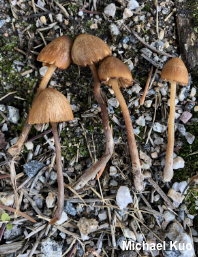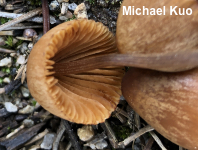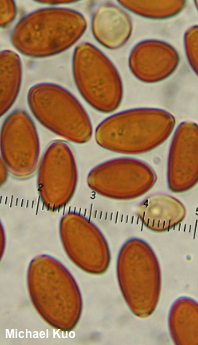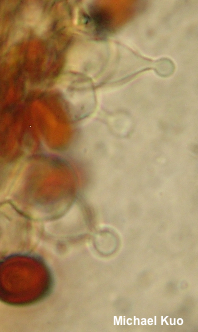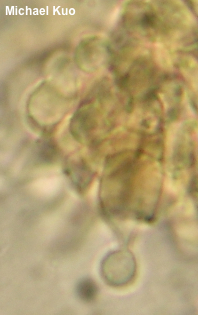| Major Groups > Gilled Mushrooms > Dark-Spored > Conocybe & Pholiotina > Conocybe semiglobata |

|
[ Basidiomycota > Agaricales > Bolbitiaceae > Conocybe . . . ] Conocybe semiglobata by Michael Kuo, August 2021 One look at this distinctive Conocybe and you'll know right away what species it is. Just kidding. Seriously, they all look the same, don't they? Conocybe is a genus for those who enjoy tedious microscope work—and in North America, it's also a genus for those who enjoy comparing the results of tedious microscope work with treatises from elsewhere (mainly Europe). Oh, and has anyone done an in-depth, DNA-based study of Conocybe species, based on large numbers of well-documented collections (including type collections) in order to sort out this God-forsaken genus? Wait for it . . . Yeah, no. Don't wait for it. In short, one wonders whether the best strategy might be to call all of them either "Conocybe lactea" or "Conocybe tenera," as your North American field guide probably does. The white ones and the brown ones. Science. Sorry. I have a sore back today, if that's any excuse for my tirade. Conocybe semiglobata, as I should have said from the beginning, can be recognized primarily through microscopic features—especially its large spores, its cheilocystidia, and its caulocystidia. At the macro-level, its cap is paler and more convex than the caps of many look-alikes, and the striated stem can also help narrow down possibilities. Conocybe tenera is very similar but features somewhat smaller, narrower spores and a darker, somewhat more conic cap—but the name tenera is applied broadly by field guide authors, and the illustrations in these guides may not actually represent Conocybe tenera. Even without considering misidentifications, "as many as ten species now regarded as distinct have been included in the name C. tenera" Watling (1982 p. 57). Description: Ecology: Saprobic; growing alone or gregariously on the ground in grassy areas and in woods; summer and fall; widespread in Europe; North American distribution uncertain (most reports come from the western United States and western Canada, but occasional reports come from east of the Rocky Mountains); also reported in western Asia. The illustrated and described collection is from Colorado. Cap: 1–1.5 cm; conico-convex when young, becoming more convex with age; thin; dry to slightly moist; bald; orangish brown, fading markedly (hygrophanous) to medium brown or tan; margin only slightly lined at maturity. Gills: Narrowly attached to the stem; close; short-gills frequent; pale yellowish becoming orangish brown. Stem: 4–6 cm long; 2–3 mm thick; equal above a slightly enlarged base; yellowish brown to brown; finely longitudinally grooved; basal mycelium white. Flesh: Insubstantial; brownish; unchanging when sliced. Odor: Not distinctive. Spore Print: Medium brown. Microscopic Features: Spores 12–16 x 6.5–8 µm; more or less ellipsoid, with a 1–1.5 µm pore; smooth; orange-brown in KOH. Basidia 30 x 15 µm; 4-sterigmate. Pleurocystidia not found. Cheilocystidia 18–24 x 5–8 µm; lecythiform, with a neck about 1–2 x 1 µm, and a globose head 3–3.5 µm wide; thin-walled; smooth; hyaline in KOH. Pileipellis hymeniform; terminal cells obpyriform to abruptly clavate; smooth; brownish in KOH. Caulocystidia lecythiform, similar to the cheilocystidia. REFERENCES: Kühner ex Singer 1959. (Watling, 1982; Breitenbach & Kränzlin, 1995; Arnolds, 2005; Buczacki et al., 2012; Prydiuk, 2014; Hausknecht & Vesterholt, 2018; Wood & Dunkelman, 2020.) Herb. Kuo 07261903. This site contains no information about the edibility or toxicity of mushrooms. |
© MushroomExpert.Com |
|
Cite this page as: Kuo, M. (2021, August). Conocybe semiglobata. Retrieved from the MushroomExpert.Com Web site: http://www.mushroomexpert.com/conocybe_semiglobata.html |
